“Words have magical power. They can either bring the greatest happiness or the deepest despair.” -Sigmund Freud
Many of us are keenly aware of the power and purpose of language. Language provides access, connection, expression of ideas, and understanding. When we think of language, we, majority of the time, think about vocal language. However, we know that vocal language isn’t the only way we can communicate; sometimes vocal language isn’t even an option due to biological factors such as hearing problems or oral-motor problems, or intellectual disabilities or autism.
What Do We Know About Language?
We know that approximately 70-80% of children with autism experience delays in language development in some form. We also know that about 25-30% of children affected by autism are considered nonverbal (more accurately, nonvocal) or minimally verbal and remain so into adulthood. We also know that if one cannot communicate their wants and needs effectively, they are prone to engage in interfering (or maladaptive) behaviors due to experiencing high levels of frustration, anxiety, and stress. Perhaps you can relate. But language doesn’t just involve vocals- it includes written language and nonverbal communication as well.
How to Increase Language?
For our children who are considered largely nonverbal or minimally verbal, we must explore how we can teach them to communicate effectively without using vocal speech. This is where augmented and alternative communication (AAC) comes in.
AAC are methods and tools used to supplement vocal speech. These methods may include the Picture Exchange Communication System (PECS), communication boards, speech-generating devices, and even include nonverbal communication such as sign language or gestures. AAC is also useful for learners who may eventually learn to use vocal speech but are not yet able to or at least are not doing so effectively.
Ultimately, there is no research to support that the usage of AAC delays or impairs a learner’s ability or willingness to emit vocal speech. Many AAC methods can be used with very little prerequisite skills and are easy for caregivers to implement themselves.
What You May Not Know
We should never assume that because a learner is not able to vocally communicate, they do not understand what is being said to or around them. Therefore, a suggestion is that you are constantly “flooding” their environment with lots of speech by narrating daily activities, reading, singing, labeling items, etc.—repetition is key! By doing this, you are able to promote functional communication, increase social interaction, encourage generalization, and strengthen the motivation of your learner well before they develop vocal speech.
Key Takeaways
Remember, it may be difficult for you that you aren’t able to have a conversation with your child, but it is equally, if not more frustrating for them that they can’t. Always be mindful of your nonverbal communication and refrain from using words or phrases that could discourage your child and potentially negatively affect your relationship with them.
Let’s make sure our language encourages them to use theirs by modeling respectful, empathic, and kind interactions. When they are ready and can use vocal speech, they will, and for those that can’t, there’s a way to “hear” their voice through AAC. Believe in the strength within you, and in your child’s potential.
About the Author
This blog was authored by Jocelya “Josh” Webb-Gordon, a Board Certified Behavior Analyst and the Area Director of Clinical Services at the Life Skills Autism Academy in Fayetteville, NC. Josh earned her Master’s degree in Psychology with a specialization in Applied Behavior Analysis from Capella University and has been dedicated to serving families in the field of Applied Behavior Analysis (ABA) since 2013.
Currently residing in Lillington, NC, Josh lives with her husband and two children—a twelve-year-old son and an eleven-year-old daughter. She is deeply committed to providing compassionate, assent-based care and fostering positive, lasting change to help families achieve their goals and realize their full potential.





